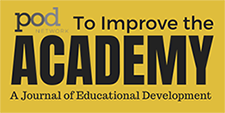Professional and Organizational Development Network in Higher Education

To Improve the Academy: A Journal of Educational Development
Date of this Version
2009
Document Type
Article
Citation
To Improve the Academy: A Journal of Educational Development (2009) 27
doi: 10.3998/tia.17063888.0027.011
Abstract
Conclusion
Given the tremendous success of the SWIs, we intend to continue to offer them for the foreseeable future, maintaining the features that faculty value most: space, sustenance, and editorial, statistical, and coaching assistance. But we will also make changes based on faculty feedback gathered during the final day’s luncheon debriefing and from the written evaluations. In addition, we intend to conduct formal research on the Institutes’ long-term effects on faculty productivity, satisfaction with scholarly work, and faculty retention. Important questions remain. For example, what is the return on investment in these Institutes, in terms of faculty productivity, career advancement, and success in such professional milestones as retention, tenure, and promotion? How does the productivity of faculty scholars who participate in these Institutes compare with faculty who do not participate? Last, why do female faculty participate in such high numbers, in comparison to male faculty?
To help sustain the writing momentum, we sponsor monthly “Faculty Writing Fridays” at the faculty center and writers’ circles that meet in small groups to read and discuss work-in-progress. These writers’ groups are common faculty support mechanisms (see Gere, 1987, for a review and Eodice & Cramer, 2001, for an example of a writing support group). Our writers’ circles spin off from the Institutes among faculty who have already established a good chemistry. Although some of these groups endure across departments and disciplines, the press of business during regular semesters sometimes intrudes on even the best of well-laid plans.
Perhaps the best reason to continue these SWIs is that our faculty get important work done in a short time and leave the experience with an authentic sense of accomplishment. They also leave believing they can be more productive scholars and more skilled time managers. Last, and just as important, they leave having met new colleagues with whom they have shared stories about disasters and triumphs in their scholarly work and built a community of writers. In short, our faculty complete the SWI well satisfied and with a substantially improved outlook for their professional scholarly success. We believe this outlook is key for the successful integration of teaching and research activities.
Included in
Curriculum and Instruction Commons, Higher Education Commons, Higher Education Administration Commons, Higher Education and Teaching Commons, Other Education Commons


Comments
License: CC BY-NC-ND